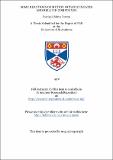Files in this item
Some reactions of methyl octadecenoates and related compounds
Item metadata
| dc.contributor.advisor | Gunstone, F. D. | |
| dc.contributor.author | Perera, Buvipali Srima | |
| dc.coverage.spatial | xvi, 113 p. | en_US |
| dc.date.accessioned | 2018-07-09T09:50:27Z | |
| dc.date.available | 2018-07-09T09:50:27Z | |
| dc.date.issued | 1972 | |
| dc.identifier.uri | https://hdl.handle.net/10023/15098 | |
| dc.description.abstract | Part I: The Methyl trans-Methyleneoctadecanoates. The sixteen isomeric methyl trans-methyleneoctadecanoates have been synthesised from the corresponding methyl trans alkenoates by the Simmons-Smith reaction, and some of their physical properties examined. Only one isomer (methyl trans-9,10-methyleneoctadecanoates) has previously been reported. The gas liquid chromatographic data are interesting in that on both polar and non-polar columns the cis and trans isomers are well separated. The methyl trans-methyleneoctadecanoates show diagnostic nuclear magnetic resonance signals around 9.8 to 9.6r. The 2,3-; 3,4-; 5,6-; 16,17-; and 17,18- isomers differ from one another, but the remainder are very similar to each other. The mass spectra of some of the isomers were examined but they do not provide much useful information. Our data, along with that previously reported for the corresponding cis isomers (see ref 21), should assist in the recognition of these compounds. For complete identification, however it may be necessary, in addition to examine the mass spectrum of the hydrogenated ester. Part II: Halogenation of Unsaturated Long-chain Hydroxy Compounds. Neighbouring group participation in unsaturated hydroxy compounds occurring during reaction at the unsaturated centre has already been observed in appropriate long-chain compounds during various oxidation reactions and during oxymercuration. The halogenation of certain hydroxyalkenoates, octadecenols and octadecenoic acids has now been examined with a view to finding out if neighbouring group participation occurs during these reactions. The halogenating agents employed were iodine monochloride, bromine and chlorine giving rise to the electrophilic reagents I+, Br+ and C1+ respectively. In most reactions only the simple addition products (vic-dihalides) were observed and these were converted into ene-halides by dehydro- halogenation since the latter have been reported previously in only a few cases. The hydroxyl group was involved in halogenation in only a few instances - mainly in iodochlorination - to give substituted tetrahydrofurans (1,4-epoxides). Lactones were obtained during the halogenation of some unsaturated acids. Attempts to obtain N-heterocyclic compounds by the reaction of long-chain amines were less successful but the conversion of methyl ricinoleate to methyl 12-amino-oleate was satisfactorily achieved. | en_US |
| dc.language.iso | en | en_US |
| dc.publisher | University of St Andrews | |
| dc.subject.lcc | QD335.P3 | |
| dc.subject.lcsh | Aromatic compounds | en |
| dc.title | Some reactions of methyl octadecenoates and related compounds | en_US |
| dc.type | Thesis | en_US |
| dc.contributor.sponsor | Colombo Plan Authorities | en_US |
| dc.type.qualificationlevel | Doctoral | en_US |
| dc.type.qualificationname | PhD Doctor of Philosophy | en_US |
| dc.publisher.institution | The University of St Andrews | en_US |
This item appears in the following Collection(s)
Items in the St Andrews Research Repository are protected by copyright, with all rights reserved, unless otherwise indicated.

